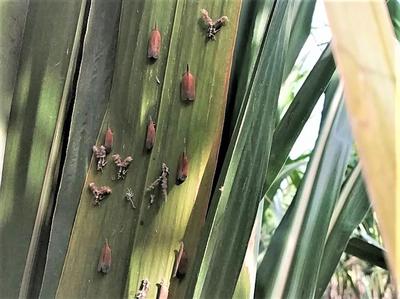Sugarcane Pyrilla
Pyrilla perpusilla
Insect
In a Nutshell
- Green to brown insects feed on the underside of leaves.
- Yellowing and drying of leaves, stunted plants.
- Production of honeydew and growth of sooty mold on leaf surface.
- Beside maize, they also readily attack other grasses and cereals.
Can also be found in
Symptoms
The pest is found on the underside of the leaves where they suck up plant sap. This causes the yellowing first and then the drying of leaves. Under low infestation, yellow patches appear on the leaf surface. Photosynthesis is reduced resulting in the stunting of the plant. Hoppers also secrete a sweet substance called honeydew that coats the leaves. This attracts opportunistic fungi whose growth blackens the leaf blade. This reduces photosynthesis even more, resulting in yield loss. Beside maize, they also readily attack sugarcane, millets, rice, barley, oats, sorghum, bajra and wild grasses.
Recommendations

Organic Control
Several parasitoids attack eggs and nymphs. Egg parasitoids include Tetrastichus pyrillae, Cheiloneurus pyrillae, Ooencyrtus pyrillae, O. pipilionus and Agoniaspis pyrillae. Nymphs are attacked by Lestodryinus pyrillae, Pyrilloxenos ompactus, Chlorodryinus pallidus, Epiricania melanoleuca. Predators of this insect also include several species of ladybirds such as Coccinella septempunctata, C. undecimpunctata, Chilomenes sexmaculata, Brumus suturalis. Egg-predators are Nimboa basipunctata, Goniopteryx pusana.

Chemical Control
Always consider an integrated approach with preventive measures together with biological treatments if available. Products containing Chlorpyriphos are effective against this pest.
What caused it?
Damage is caused by the adults of Pyrilla perpusilla, a very active plant hopper that breed throughout the year and may migrate from field to field, causing major damage. Adults are greenish to straw-colored and about 7-8 mm in length. They are usually found feeding gregariously on plants and jump off readily when disturbed. Their pointed snout hide the mouth parts with which they pierce and suck plant tissues. Spreading of the pest is favored by high humidity and rapid plant growth, for example in heavily manured or fertilized fields. Excess irrigation or the rainy season also contributes to its propagation.
Preventive Measures
- Monitor the field regularly for symptoms of the pest.
- Remove infected plant after harvest and burn them.
- Do not use broad-range insecticides as this can affect negatively beneficial insects.



